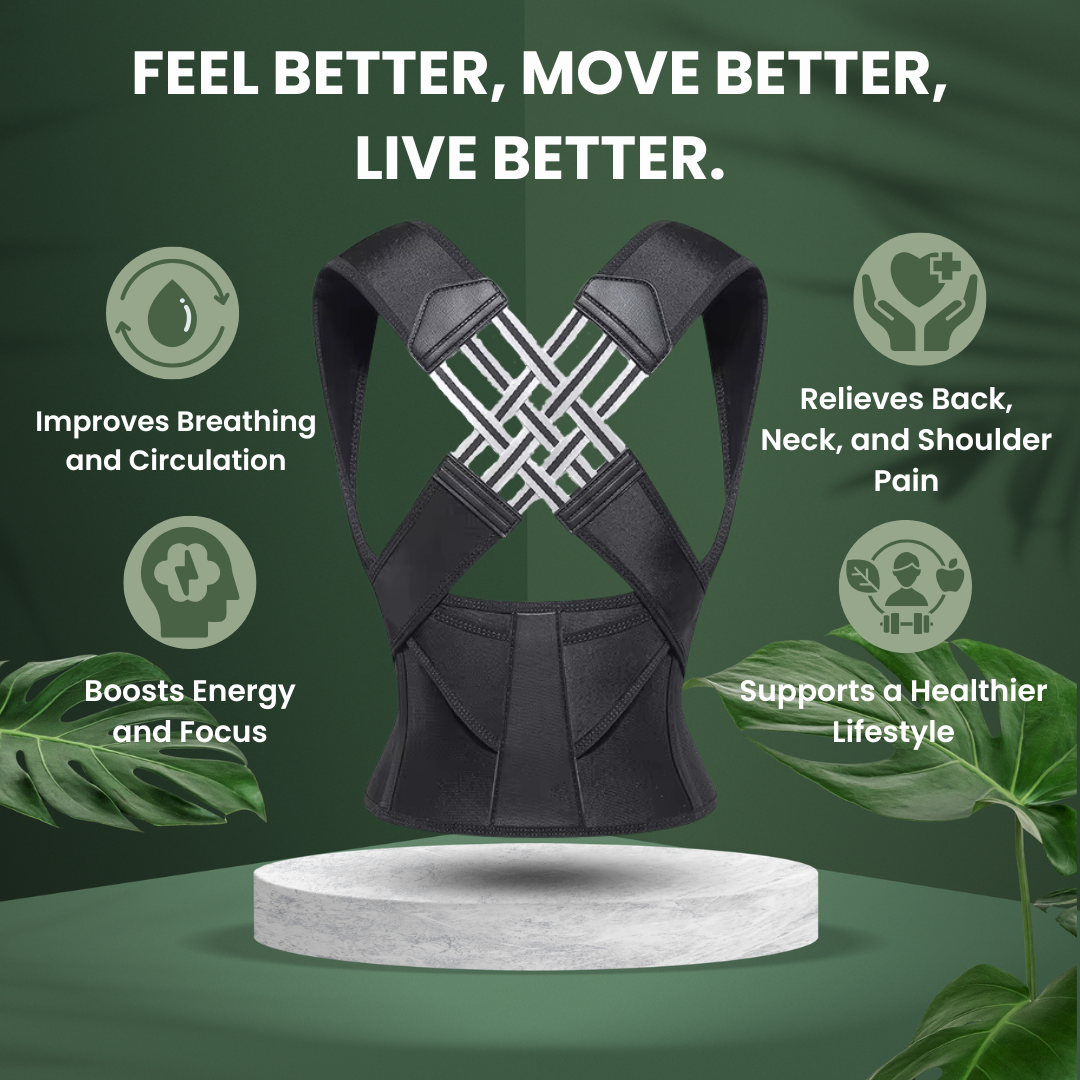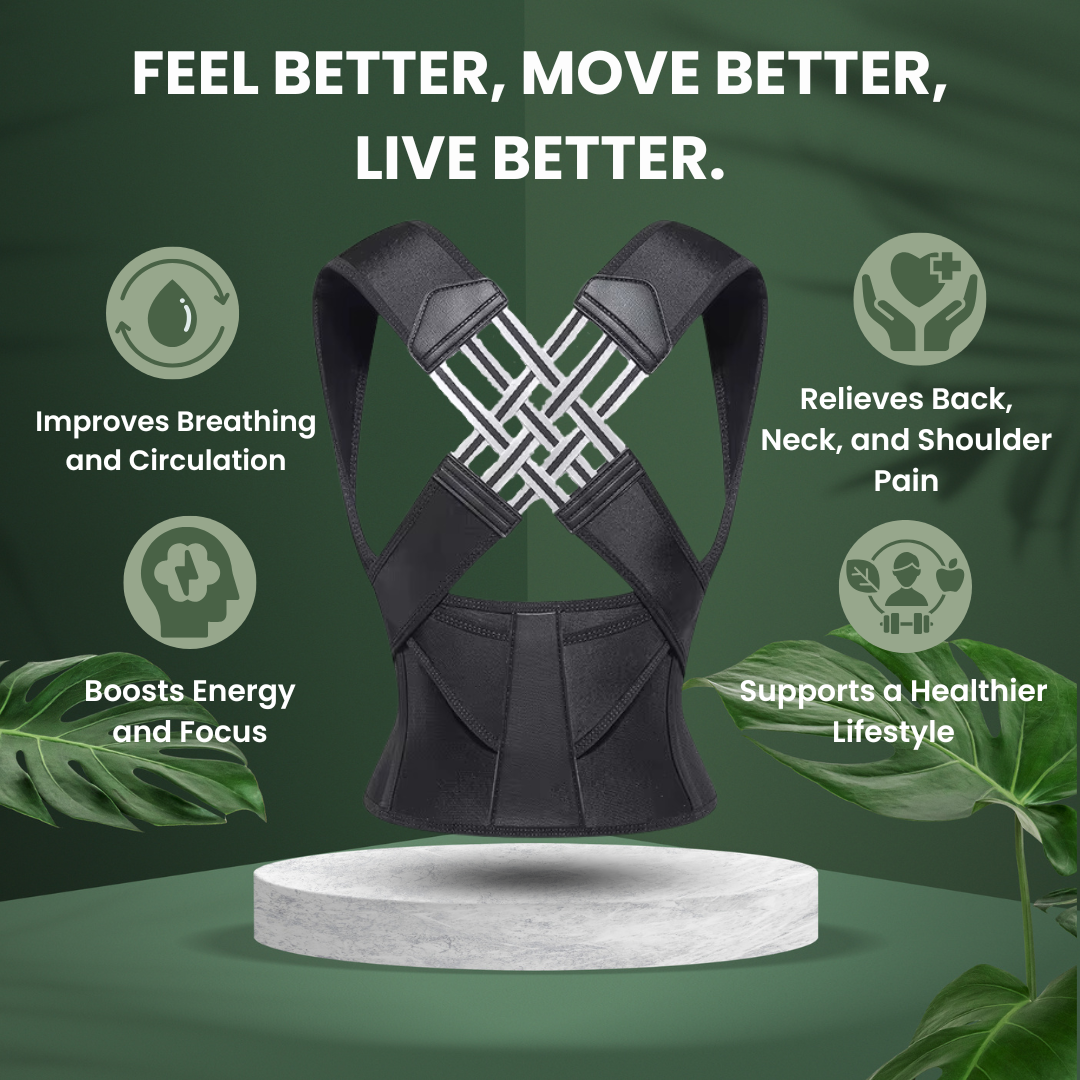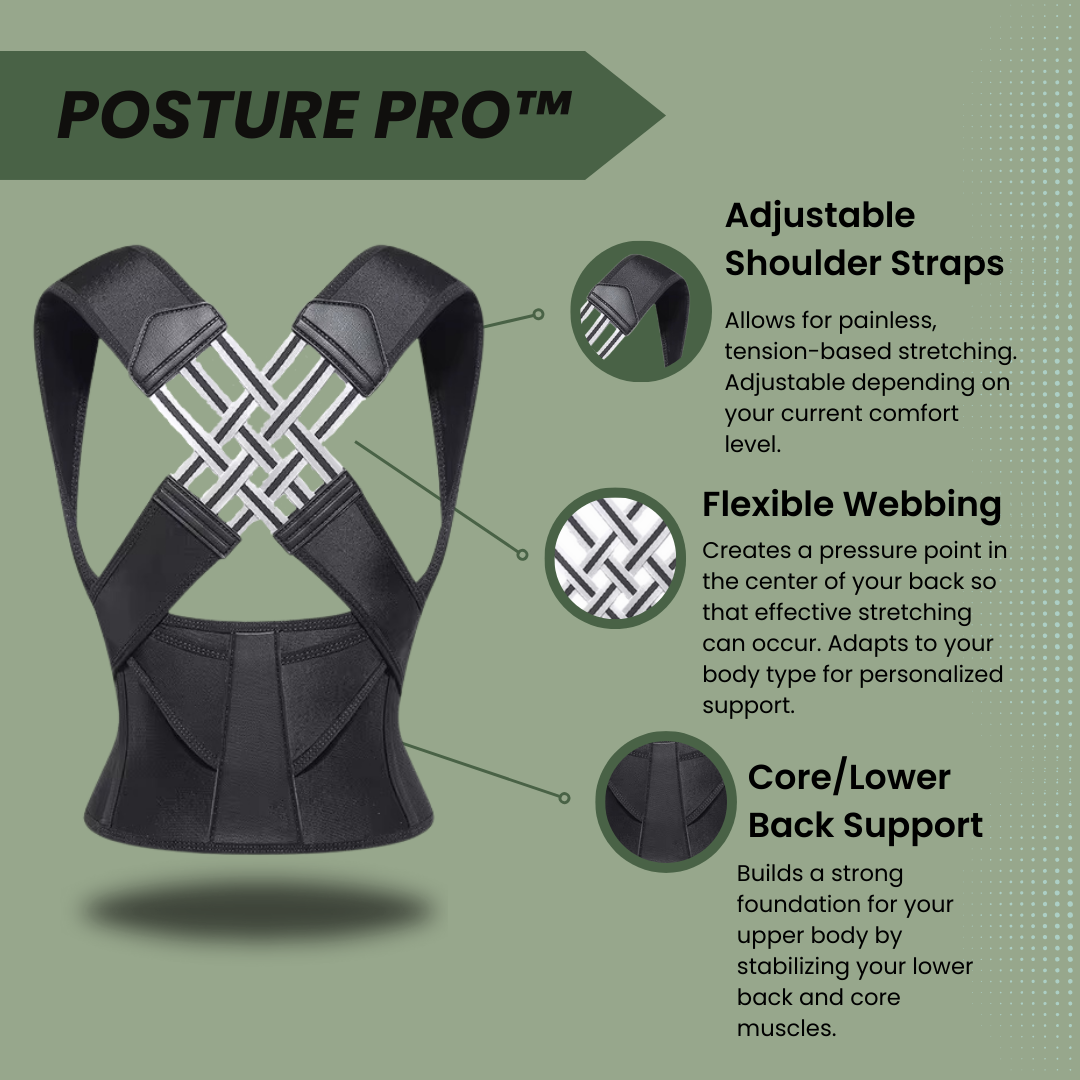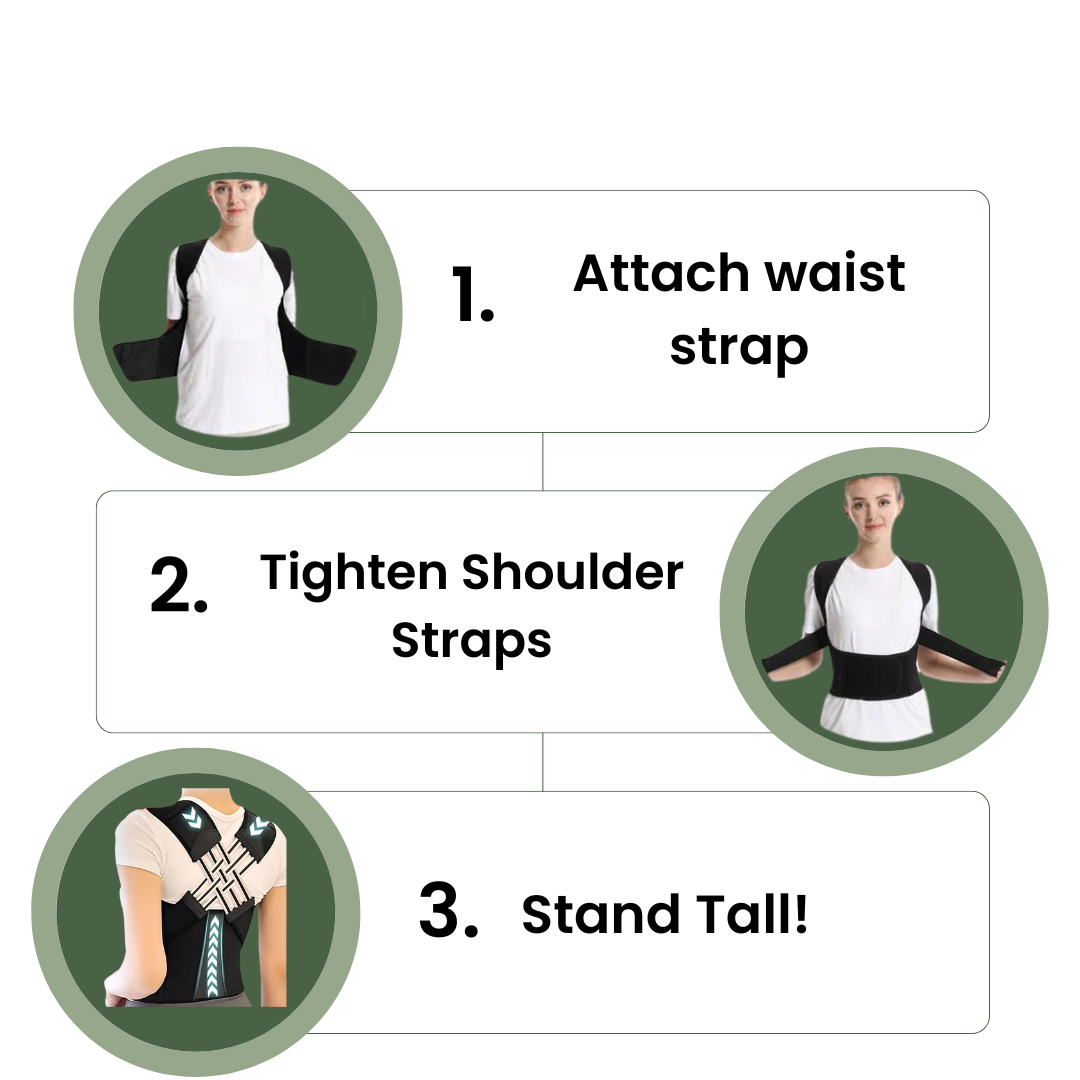Many people deal with back pain. Good posture can help fix this problem. This blog will talk about the long-term benefits of good posture, like less pain and more energy. Keep reading to learn how to stand tall and feel better.
Key Takeaways
- Good posture helps lessen back and neck pain. It does this by keeping the spine in its natural shape. This reduces muscle strain.
- Standing or sitting right improves lung function and blood flow. This means more oxygen gets to your muscles, making you feel more energetic.
- Having good posture can make you feel more confident and happy. Studies show standing straight makes people think positively about themselves.
- Tools like posture correctors can guide your body into better alignment. They should not replace exercise but can remind you to stand or sit properly.
- Simple daily actions, like adjusting how you work at your desk or doing exercises, support good posture. Keeping electronics at eye level also helps avoid neck strain.
What Is Good Posture?

Good posture means holding your body in a way that puts the least strain on muscles and ligaments, whether you are moving or still. It involves keeping the spine's natural curves aligned – these are the cervical (neck), thoracic (mid-back), and lumbar (lower back) regions.
This alignment is key for standing, sitting, or lying down correctly.
Proper posture isn't just about standing tall; it's about maintaining the spine's health through all of life's movements.
To do this right, engage your core muscles to support your lower back. Your shoulders should be back but relaxed, and your head should be in line with your shoulders, not poking forward.
When sitting, feet stay flat on the ground or on a footrest if they don’t reach. Maintaining this can prevent common discomforts like low back pain and muscle strain.
Long-Term Health Benefits of Good Posture
Good posture has lasting health benefits. It can reduce back and neck pain, improve lung capacity, and enhance circulation. Good posture also helps in boosting confidence and mood.
Reduced back and neck pain
Standing and sitting the right way lessens back and neck pain. People who work in offices often have these pains. Between 15% and 43.3% of them say they hurt from neck pain. Using ergonomic training helps a lot.
It makes pain go down and life better.
Fixing how you sit at your desk can stop neck and lower back pain before it starts. This means adjusting your chair, computer, and desk so everything is just right for your body. Core strength plays a big part too, as strong core muscles keep your spine happy by supporting it correctly.
Improved lung capacity and circulation
Maintaining a suitable posture expands your chest and allows your lungs to intake more air effortlessly, particularly during physical exercise. This provides your body with more oxygen.
Increased oxygen level enhances energy and optimizes muscular function. Standing upright also prevents organ compression, facilitating improved blood circulation throughout your body.
Enhanced circulation decreases fatigue and prepares you for physical activities.
Consciously maintaining an upright posture whether seated or standing enhances respiration and facilitates smooth blood circulation, spreading nourishment rapidly to all body parts, ensuring overall functionality.
This is comparable to efficient traffic management; where there are no delays and every object arrives at its intended destination promptly, leading to a well-maintained and vibrant body.
Enhanced confidence and mood
Good posture isn't just about physical health; it also has a positive impact on mental well-being. Research shows a connection between good posture and an uplifted mood, along with increased energy levels.
A study in *PLoS One* found that good posture could boost confidence and reduce negative thoughts especially in women dissatisfied with their bodies. Slouching may lead to more pessimistic thinking overall.
Moreover, improving posture can lead to a more optimistic outlook and greater self-assurance. When we stand or sit up straight, our body language sends signals to our brain that we are confident and capable which can reflect positively on our mood.
So it's not just about looking good; it's also about feeling good!
How Posture Correctors Can Help
Posture correctors can support spinal alignment, helping to encourage muscle memory for better posture over time. Want more tips? Read the full blog!
Supporting spinal alignment
Good posture helps maintain the natural curves of the spine, supporting spinal alignment. When the spine is aligned correctly, it reduces strain on the ligaments and muscles that support it.
Proper alignment also facilitates efficient movement and prevents undue stress on certain areas of the body. Posture correctors can assist in this by promoting awareness of one's posture through providing sensory feedback, thus encouraging optimal spinal alignment.
It is key to note that relying solely on posture correctors might not be advisable as they are designed to be temporary aids for addressing muscle imbalances from improper positions.
The use of these tools improves proprioception - the body's ability to sense its position. Better spinal alignment can lead to reduced back and neck pain while promoting overall spine health over time.
Encouraging muscle memory for better posture
Encouraging muscle memory for better posture is crucial for long-term improvement. As we consistently practice good posture, our muscles "remember" this positioning, making it feel more natural over time.
Posture correctors can help foster this muscle memory by providing support and gently guiding the body into proper alignment. It's also crucial to note that engaging in movement and strengthening exercises plays a significant role in improving muscle memory for enhanced posture habits.
These activities contribute to the overall strength and flexibility of muscles essential for maintaining good posture each day.
Incorporating mindfulness of body position into daily routines promotes better postural habits. This increased awareness assists in reinforcing the neural pathways associated with proper alignment, further supporting muscle memory development.
Through these practices, individuals are gradually able to maintain good standing or sitting posture without relying solely on external aids such as posture correctors.
Tips for Maintaining Good Posture Daily
- Stand and sit up straight, keeping your shoulders back and relaxed, aligning your ears, shoulders, and hips.
- Take regular breaks to stretch and move every 20-30 minutes, incorporating shoulder rolls or gentle side stretchesto relieve muscle tension.
- Create an ergonomic workspace at home or in the office by adjusting your chair height, monitor position, and keyboard placement to support good posture.
- Exercise regularly to strengthen core muscles and improve flexibility, incorporating activities like yoga, Pilates, or simple bodyweight exercises.
- Keep devices at eye level to avoid "text neck" and use smartphone apps as reminders for posture checks throughout the day.
Conclusion
Good posture is more than just a physical aspect; it significantly benefits our long-term health. Maintaining good posture aids in reducing back and neck pain, improving lung capacity and circulation, and boosting confidence and mood.
Integrating postural exercises and mindfulness techniques into our daily routine can help us achieve these benefits. By embracing proper posture habits, we contribute to a healthier body, mind, and overall well-being.
In conclusion, the long-term benefits of good posture extend beyond physical appearance to encompass holistic health improvement. It's not only about appearances but contributes to reduced pain levels, enhanced energy throughout the day, as well as promoting better exercise form.
Through understanding the importance of maintaining good posture, we empower ourselves with proactive steps towards living a healthier lifestyle.
FAQs
1. What are the long-term benefits of maintaining a good posture?
Maintaining a good posture, whether standing or sitting, can provide numerous health benefits. It helps in spine alignment which reduces muscle strain and tension headaches. Good posture also improves mood, energy levels, lung capacity and blood circulation.
2. How does having a good posture affect my physical appearance?
Good posture enhances your physical appearance by improving body alignment and range of motion. When you stand or sit with proper spinal alignment, it creates an upright stance that makes you look confident and healthy.
3. Can practicing good postural habits help alleviate back pain?
Yes! Practicing good postural habits plays a crucial role in alleviating back pain as well as neck tension. By strengthening your core muscles including abdominal muscles and back muscles, you ensure better spinal stabilization reducing chances of experiencing low back pain.
4. Does maintaining a neutral spine influence joint health?
Absolutely! Maintaining a neutral spine aids in preserving bone health as it prevents muscular imbalances causing undue stress on joints thereby promoting overall joint health.
5. Can regular exercising improve my standing and sitting posture?
Definitely! Regular exercises like squats target the core strength involving postural muscles such as abdominals along with pectoral muscles ensuring optimal shoulder tension relief which ultimately results in improved standing and sitting posture.
6. How does proper head alignment contribute to my overall wellness?
Proper head alignment is key to reducing muscle tension leading to fewer instances of tension headaches while enhancing mood improvement by warding off negative thoughts thus contributing significantly towards overall wellness.



















